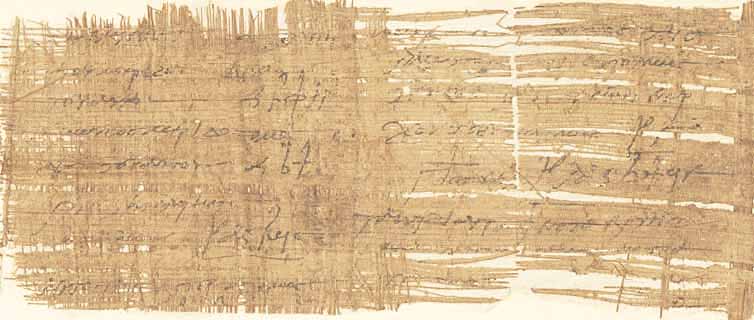P. 11517 V
In this fragment of a novel or an aretalogy on a papyrus from the 2nd century CE, there is a rhetorical duel between Daulis, who has just seized Delphi with his army and criticizes the oracle practice, and the prophet of the sanctuary, who defends the divine truth of the oracle.
A Clash of Worldviews – this papyrus offers an insight into the Greek intellectual world of the 2nd century AD. The text can be dated to this time based on its script. It consists of three unusually wide columns, of which only the middle one, containing 29 lines, is largely intact. The outer columns, with 24 and 29 lines respectively, are heavily fragmented. The text recounts a story about an attack on Delphi. Its renowned sanctuary, one of the most important religious centers of the Greek world, attracted people from far and wide seeking answers from the Oracle of Delphi. The priestess, known as the Pythia, would sit above a fissure in the earth emitting volcanic gases and convey the responses of the god Apollo. Grateful petitioners donated valuable offerings over the centuries, making the sanctuary rich and influential.
From the fragmented text, we learn that an enemy army has occupied Delphi, committing various atrocities. Daulis, the army’s leader, threatens the prophet of Delphi—responsible for interpreting and announcing the Pythia’s oracles—with a sword. Daulis accuses the priests of exploiting people’s faith to manipulate them with oracles and extort money. As punishment, he threatens to sacrifice the prophet’s blood to the war god Ares. The prophet, however, invokes the divine truth and Themis, the divine justice, who preside over the sanctuary, and predicts that Daulis will face due punishment for his sacrilegious acts.
During the 2nd century AD, Delphi flourished, but this prosperity also caused criticism of its practices. Some philosophers and intellectuals accused the oracle priests of deceiving the populace, using arguments similar to those made by Daulis. It can be assumed that his text originated from someone defending Delphi, portraying Daulis as embodying the critics‘ views and likely ensuring that he is punished in the story’s conclusion to affirm the god’s power and the oracle’s truth. The story may be a scene from a novel or an aretalogy—a text praising a god, often through miracle or retribution narratives.
It is likely that a miraculous event ended Daulis’ rule over Delphi and his life, as the author draws on a long tradition of such tales. The Greeks had numerous stories of enemies being repelled by lightning, landslides, earthquakes, snowstorms, or apparitions of heroes when they attacked Delphi, as with the Persians in the 5th century BC or the Celts in the 3rd century BC, and even when they had already seized Delphi, as with the Phocians, a Greek tribe, in the 4th century BC. This raises the question of whether the event in the text refers to one of these historical incidents or if the author invented an attack inspired by such narratives. Unfortunately, the text does not even clarify whether the attackers were Greeks or barbarians. If a specific event is depicted, it likely relates to mythology, particularly the attack by the Phlegyans, a wild tribe hostile to Apollo and Delphi.
This papyrus illustrates how, drawing on well-known stories from the cultural memory of the Greeks, a literary battle of worldviews was waged. A rational, skeptical perspective is countered with the assertion that Apollo’s power in the human world is real, and he is fully capable of defending his sanctuary.



